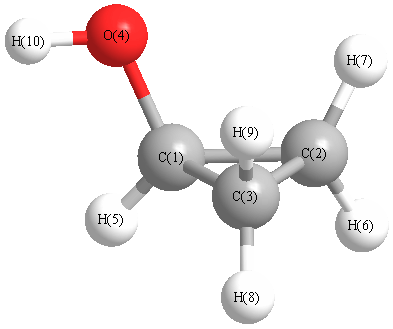Vibrational Frequencies calculated at QCISD(T)=FULL/6-31G*
| Mode Number |
Symmetry |
Frequency
(cm-1) |
Scaled Frequency
(cm-1) |
IR Intensities
(km mol-1) |
Raman Act
(Å4/u) |
Dep P |
Dep U |
|---|
| 1 |
A |
3713 |
3713 |
|
|
|
|
| 2 |
A |
3253 |
3253 |
|
|
|
|
| 3 |
A |
3238 |
3238 |
|
|
|
|
| 4 |
A |
3164 |
3164 |
|
|
|
|
| 5 |
A |
3153 |
3153 |
|
|
|
|
| 6 |
A |
3128 |
3128 |
|
|
|
|
| 7 |
A |
1550 |
1550 |
|
|
|
|
| 8 |
A |
1492 |
1492 |
|
|
|
|
| 9 |
A |
1452 |
1452 |
|
|
|
|
| 10 |
A |
1334 |
1334 |
|
|
|
|
| 11 |
A |
1258 |
1258 |
|
|
|
|
| 12 |
A |
1220 |
1220 |
|
|
|
|
| 13 |
A |
1211 |
1211 |
|
|
|
|
| 14 |
A |
1157 |
1157 |
|
|
|
|
| 15 |
A |
1097 |
1097 |
|
|
|
|
| 16 |
A |
1086 |
1086 |
|
|
|
|
| 17 |
A |
1010 |
1010 |
|
|
|
|
| 18 |
A |
958 |
958 |
|
|
|
|
| 19 |
A |
857 |
857 |
|
|
|
|
| 20 |
A |
837 |
837 |
|
|
|
|
| 21 |
A |
776 |
776 |
|
|
|
|
| 22 |
A |
415 |
415 |
|
|
|
|
| 23 |
A |
409 |
409 |
|
|
|
|
| 24 |
A |
336 |
336 |
|
|
|
|
Unscaled Zero Point Vibrational Energy (zpe) 19050.8 cm
-1
Scaled (by 1) Zero Point Vibrational Energy (zpe) 19050.8 cm
-1
See section
III.C.1 List or set vibrational scaling factors
to change the scale factors used here.
See section
III.C.2
Calculate a vibrational scaling factor for a given set of molecules
to determine the least squares best scaling factor.
